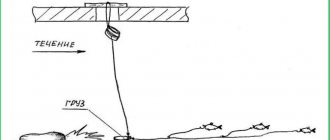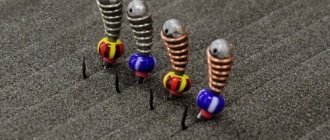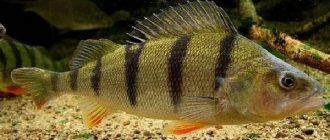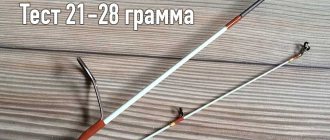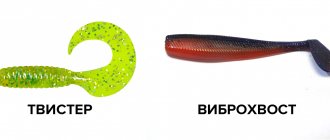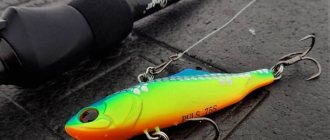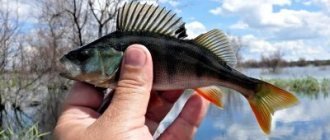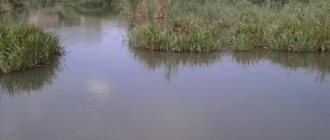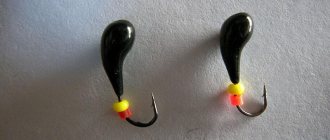Features of silicone baits
Any rubber bait is equipped with a hook, which can be standard or with a cast jig head. The main feature of these baits is the hardness of the material used. The softer it is, the more active the game when fishing. But not all of them are soft and elastic. So, for example, a vibrating tail is made of hard and dense rubber. The reason for this is the pressure at the bottom of a reservoir or river, which can easily damage soft rubber.
The shape of the rubber used is also important. The opinion that catching perch with silicone in winter is most successful using the classic form is erroneous. Other baits that are in no way inferior to standard ones are also used with success. With even wiring, the bait moves and its movement reminds the fish of a well-fed and thick worm, which is sure to interest the perch.
Features of winter fishing with silicone
Ice fishing imposes a number of restrictions on the use of rubber. First of all, this concerns the flexibility of the product and aromatic properties, if it is so-called edible silicone. Smell, an important factor influencing the number of bites in the summer, loses its influence in winter as the temperature drops. Aromatic substances spread much worse in cold water, and only act when the fish comes at close range, so there is no significant difference in terms of attracting predators from long distances in the work of edibles and regular silicone. However, rubber still does not lose its edible properties, which are so attractive to predators - the soft structure of the material, as well as the addition of salt, reduce the chance that the fish will spit out the bait immediately after biting.
Packages with rubber should be kept warm during winter fishing, since if there is condensation in a pack of rubber, the bait will quickly become covered with an ice crust. Cheap, low-quality products can lose flexibility, and therefore their characteristic play, even when exposed to cold water.
A variety of silicone baits
When entering any specialized fishing store, a fisherman is faced with a huge selection of silicone baits. The provided assortment differs in size, color and shape. The main types of bait for catching perch with silicone in winter are as follows:
- Twisters
- Worms
- Vibrotails
- Slugs
- Creatures
- Octopuses
The most popular are vibrotails and twisters. The latter have a cylindrical shape and a flat tail, which allows them to attract a predator. The first ones imitate the movement of small fish, which is sure to interest the perch.
Worms made of rubber are popular among jig lovers. They are used on different gear and are quite effective when catching predatory fish. There are several types of such baits:
- Active. They are very similar to the classic twister, but have a thin and rather elongated body. They have proven themselves well when catching predatory fish.
- Passive. Externally, the bait looks like an ordinary worm. There are no moving elements. Indispensable when catching predatory fish using jerks.
Slugs are a classic of the passive type. Used in difficult conditions (stones, snags, thickets) for hunting sedentary predatory fish.
Creatures are bait in the form of various underwater objects. The most popular are crustaceans. Used to catch active predators.
Octopuses - used when catching large perch. They have a good response to jerks, and play well during a free fall and not a fast retrieve.
Rating of silicone baits for perch
The rating of catchable baits includes:
- twisters;
- vibrotails;
- slugs.
The most famous and promoted brands:
- Lucky John;
- Ukrainian Fanatik;
- Relax.
Today we will focus on silicone vibrating tails:
- Boxer 3.5 from Fanatik . Lures made from edible silicone. You can choose different colors.
- Ponton 21 Awaruna . Jig baits with high quality action. Vibrations are transmitted to the entire surface.
- Bugsy shad Lucky John . The rubber works when the minke whale refuses to feed and behaves passively.
- Swing impact . This is an oblong ribbed rubber. The tail plays actively during any retrieve.
- Tioga Lucky John . An interesting bait option, which, thanks to its elongated tail, provokes striped bass to attack even in remote places.
Type of silicone according to the material used
Catching perch in winter with silicone baits has a number of features. The success of the bite depends on the material used.
There are a couple of types of silicone used:
- “Inedible” baits are the bait that gave impetus to the development of the jig fishing method. It is made of plastic, preheated and poured into pre-prepared molds. There are many options for silicone. All of them are unique in their own way and are used depending on the situation.
- “Edible” baits are a widely used and common type. Used for fishing regardless of the time of year. Made from rubber with amino acid impurities. To attract predatory fish, the material is impregnated with an attractant, which significantly increases interest in the bait. The main disadvantage is the low strength threshold. Sometimes one bite can damage the bait to such an extent that it will need to be replaced.
- Floating baits. There are two types: edible and regular. Their ability to maneuver through water depends on the density of the material. The ability not to sink gives the bait a number of advantages, which include:
- Silicone imitates a fish digging in the ground, which attracts large fish.
- Allows you to carry out wiring without unnecessary movements. The fisherman easily twitches the line, the bait stands in one place, but at the same time imitates the movement of small fish, which attracts even a well-fed predator.
- Good visibility of the material used allows you to fish in troubled waters. The existing color scheme makes it possible to choose bait for any fish. The color of silicone for perch is selected based on a number of factors, which include weather, fishing depth, time of year, etc.
Artificial bloodworms and maggots. Widely used when catching peaceful fish and hungry predators. They look like live bait and have a scent that interests fish, obtained by using aromatic oils.
What gear to choose for ice jig
There is no need to invent anything here. For winter fishing with silicone baits, the same gear is suitable as for regular winter trolling or fishing with jigs. It is better to equip the rod with an elastic nod, with which you can give the bait additional play. The diameter of the fishing line depends on what kind of predator you are going to hunt. For pike and pike perch, the thickness of the fishing line is selected from 0.15 to 0.18 mm. When fishing for toothy fish, it is better to also use elastic metal leashes. For perch hunting, a fishing line up to 0.12 mm is suitable. The choice of hooks is influenced by the structure of the bottom. Where there is a high probability of snagging (snags, vegetation, stones), single and offset hooks are used. And for a flat bottom, it is better to take doubles and triples - they are more grippy.
Top 10 silicone baits
In winter, perch can be caught well on silicone using almost all baits. But there are still a number of baits whose ratings are significantly higher than others. We list the most popular of them:
- Reins Rockvibe Shad2.
- Kosadaka Vibra.
- Mann's Predator 70.
- Lucky John Pro Series Mister Greedy.
- Bass Assassin Curly Shad.
- Relax Koryto.
- Fox Rage Fork Tail.
- Lucky John Pike Idol.
- Mann's Stalker 5.5.
- Vibro Worm 3.4.
Time to catch the predator
There are different opinions regarding the optimal time for catching perch in winter. Like any other fish, perch bites very rarely throughout the day. As a rule, periodic “exits” occur, i.e. periods of high predator activity , often very short. They can occur at any time of the day, but for specific bodies of water there are patterns, knowing which an angler can hope for successful fishing.
Expert opinion
Knipovich Nikolai Mikhailovich
Zoologist, hydrobiologist. I am interested in fishing at a professional level.
Important! In winter, perch prefers periods of thaw or days with stable atmospheric pressure. High atmospheric pressure or foggy weather are unfavorable conditions for fishing.
Tackle for winter perch fishing with silicone
Most anglers when fishing for perch in winter using silicone use ordinary winter fishing rods with a nod. Catching perch with silicone from the ice of time can be done using the following equipment:
- Fishing with rubber using a retractable leash is very simple in design. Can be used on any type of reservoir. The length of the leash is at least 100 cm. When using baits that are small in size and weight, additional weight is used, which can be small lead pellets.
- Drop-shot tackle. The difference between this method and others is the location of the bait and fishing line on different planes. A weight is attached to the end of the fishing line and a knot is tied with a hook on which the rubber bait is fixed.
- Fishing using non-immersed rubber. The method implies the absence of any weighting agent. Only silicone bait and hook are used. A fishing line is tied onto it and the bait is attached. The body of the hook is hidden in silicone.
- Jig heads. It is used with flexible or free fastening, which makes it possible to use a variety of loads. Allows for quick bait replacement. Ideal for catching perch in winter using a silicone microjig.
Fishing in winter with silicone baits
Trying to catch perch from the ice with edible silicone baits, used in microjig in summer, when everyone around is fishing with spinners, balancers and jigs, seemed, to put it mildly, unusual. However, this idea has been incubated for a long time; there was simply no suitable opportunity to bring it to life. But then somehow I came across a video on the Internet in which they filmed fishing with silicone from ice - this became the message for starting the experiment: if others are trying, what’s stopping us?
A week later, the first purposeful fishing trip took place with completely new gear and all the classic winter gear left at home, so that there was no chance of slipping off.
The fishing rods were reassembled. The carbon whips were replaced with thin fiberglass ones 30 cm long, the fishing rods were equipped with small lightweight reels with quick line release keys, and bright silicone nods were installed. The nod, as practice has shown, could have been omitted, but it was still more practical. They decided to make the fishing line thinner, replacing the “balancer” section with a section of 0.2 to 0.16 mm. On a thin line, silicone, by all accounts, should play more naturally. From the baits we chose twisters, worms and various krakozyabrs of different colors with a length from 1 to 5 cm. After gossip, we chose three installation methods (photo 1).
- Blind installation - the bait is put on a jig head weighing 0.5–1 g, the fishing line is tied with a blind knot to the eye of the jig head.
- Sliding installation - first put a silicone stopper on the main line, then a hook with bait. The hook needs to have a large eye so that it has more freedom when moving along the fishing line. At the end of the rig we tie a weight weighing 1–3 g.
- Blind installation with a leash - on the main fishing line we knit a leash with a hook and bait, and tie a weight at the bottom. The length of the leash is from 10 to 20 cm, the thickness is 0.12–0.14 mm, the distance from the load is from 15 to 30 cm.
The play of a silicone bait can be very varied, but in general you can use standard balancing wiring: toss-pause. However, regardless of the installation method, you need to knock the load on the bottom. This simple technique, as the practice of subsequent fishing shows, attracts perch much better than simply playing bait in the water column. The fact is that perch often feeds not only on fry, but also on various crustaceans and other living creatures that live on the bottom, and tapping a weight on the bottom always creates, albeit a small, but still turbidity, which imitates potential perch food swarming in the silt.
Tapping, by the way, is useful not only on muddy bottoms. Knocking on a hard bottom and stones also attracts perch, and a perch attracted by sound will always react to a bait moving near the sound source, especially if it looks like a food item, smells delicious and looks appetizing. And it’s not just perch that reacts to silicone. Sometimes it was possible to pull out a kilogram pike, but mostly there were annoying cuts or tears of our baits by a large pike.
After a dozen fishing trips, preferences emerged in rigs, baits and wiring options. It’s worth making a reservation here: a lot depends on the fishing conditions, so the proposed rating is rather hypothetical, and yet the sliding rig turned out to be the most catchy. Perches most often responded to a free-falling bait after hitting the bottom with a sinker and pausing. The wiring looks like this: we throw the bait with a load 20–30 cm from the bottom, wait for the load to hit the bottom and, slightly pulling the line, hold a pause for 5–10 seconds. With a nod, such wiring is much easier to control. The perch always greedily attacked the silicone precisely on the fall or immediately after the hook made contact with the end weight (in this case there was a lot of silt in the perch’s mouth).
When fishing among the reeds, several times I had to put two stoppers on the line - above and below the bait sliding on the hook. This allowed the height at which she played to be adjusted. The adjustment was a big help when the perch in the reeds moved to the top layer. For example, in the morning a striped fish pecked at the very bottom, and in the afternoon it was already a meter away from it, and given the total depth of 1.5 meters, it ended up almost under the hole. Perhaps he was hunting for a fry, and the bait raised to the same height ended up under his nose and greedy bites followed. Subsequently, when installing such equipment, we always began to install two stoppers.
In second place in terms of catchability was a blind rig with a leash. It was significantly inferior to the sliding rig, but if there were areas with stones, sharp steps or branches lying on the bottom, it performed much better. Especially in places where there was at least some current. Of course, we didn’t go to the very stream of the riverbed, the load of 3 g is too small and it will be carried away, but in moderate currents, especially in places where there is a hard bottom with shells, the installation with a leash worked well.
This is not surprising, because in essence it is a small copy of a diverting leash, which is always good for catching perch in the open water season. Wiring with this installation is done faster and sharper than with the previous one, with minimal pauses of up to 3 seconds, and sometimes without them. The constant knocking on the bottom with the bait falling caused powerful bites with the bait being completely swallowed. When fishing in snags, I recommend using a larger offset hook - the perch swallows the bait greedily, and there are practically no escapes.
Unfortunately, the blind rig on the jig head did not perform as well as we had hoped. Several dozen perch were caught with it, but in general it was significantly inferior to other rigs, and we stopped using it, although I know that such rigs work, in particular for pike perch (with a vibrating tail attached). This is a foundation for the future, and if anything comes of it, readers will not be left in the dark.
Of the baits, the most catchy baits turned out to be imitations of dragonfly larvae, mayflies, crustaceans, and thin worms. Classic twisters, rippers, and slugs were not particularly popular. The most catchy ones include the following: Hogy Hog nymph from Lucky John in cola color (photo 2), Joy larva from Azura in motoroil color (photo 3), Micro Babbling from Fishing ROI acid color C 913 (photo 4), Azura nymph in green (photo 5), Fox Nimble with a thin tail, green with sparkles (photo 6).
These baits worked well in our conditions, you can try them in other colors or choose something of your own for a specific location. In any case, I strongly advise you to catch perch from ice using silicone. These are new emotions, wiring options, equipment, and most importantly - the greedy bites of the striped robber!
Winter fishing technique with rubber
In order to lure perch during winter fishing, avid fishermen use all sorts of tricks and methods. The main methods are:
- Various taps of the bait on the bottom.
- Drops and various bait tosses.
- Lowering and raising the tires at different speeds.
- Twitching and playing with bait.
Each of these methods is unique, has its own implementation characteristics and effectiveness, which depends on many factors. The final choice of method is made on the pond depending on the bite, weather conditions, etc.
The number of useful and informative videos about winter perch fishing is varied. We invite you to watch an educational video from an experienced fisherman about how to catch perch and what bait to choose.
Catching perch with silicone video
Equipment for fishing with silicone
There are approximately 10 most common equipment options, “tailored” to different quiet hunting conditions and wiring techniques. The following fastening methods are considered to be working and most effective:
- jig head;
- hinged design;
- diverter leash;
- drop shot;
- tyrrett;
- Texas rig option;
- Carolina rig;
- split shot.
It would be unfair to just name the types of equipment. Therefore, we will look in more detail at each of the presented types of equipment for catching a predator.
Jig head
This type of fastening is considered a fishing classic. She is favored by experienced fishermen and “first-graders”. The head weight is aggregated with a fixed hook. In stores you can buy jig heads weighing from 1 to 10 grams with hooks of various sizes. The jig head can be of different shapes, such as:
- ellipse;
- hoof;
- ball.
There are other options.
Hinged design
This option involves using:
- head weight;
- offset hook.
It is possible to use a double or tee. The difference is that the weight has two eyes: one for an offset hook, the second for a leash with the main fishing line or cord. In this design, edible twisters are constantly in motion with active oscillation. The effectiveness of twisters and vibrating tails on a hinged structure has been confirmed by practice. This type of equipment is suitable for attaching passive worms.
Retractable leash
This option uses:
- main line;
- weight;
- additional leash with bait.
If it is necessary to feed light bait over a long distance, a retractable leash is recommended. Feature: the weight controls and does not allow the silicone to move out of the biting zone. This is important if perch fishing takes place in the current.
Drop shot
The design of this equipment is similar to the previously considered option: a diverter leash. As you can see, in the picture the baited hook is attached to the main fishing line or cord. The weight is located at the bottom of the structure.
Tyrrett
Tirette works effectively in snarled areas, at the bottom of a reservoir. Sinker, shaped like a plow.
Texas rig option
A modernized version of equipment for catching predators in snags. The bait is attached to an offset hook. A weight is put on the main fishing line or cord, which can be made in the form of a bullet with two through holes at the edges. Behind it is a bead that protects the hook knot. Feature: the load moves freely along the fishing line.
Carolina rig
This is not a separate species, as many people mistakenly believe, but a variety of the Texas variant. In this case, as shown in the figure, the hook with a silicone nozzle is located on a separate leash.
Split shot
Equipment is necessary when fishing for stripers at shallow depths. The silicone is on the main line. And at a distance of 300–400 mm, as shown in the figure, a float pellet is located on top.
Where and how best to store silicone
Any fishing with a spinning rod involves the use of silicone baits. For a long time, fishermen have collected a wide variety of baits in their fishing box. If storage rules are not followed, they change color, shape, rot and fall into pieces. Residual water on the material exposes metal parts to corrosion, as a result of which they can lose strength and break when bitten by a large individual. Therefore, storage of nozzles must be carried out in accordance with all requirements.
4 rules for storing silicone baits
Storing bait requires compliance with certain rules. Each type has its own characteristics. Let's talk about each of them in more detail.
Storing silicone bait
In order for silicone baits to have a long service life, you must adhere to a number of simple recommendations:
Storing edible baits
There are two types of edible materials used on spinning rods:
- Lures made of silicone and impregnated with attractants. The impregnation process is carried out after receiving the finished product.
- The production of bait with a silicone odor is made from pre-scented materials.
The process of preparing to save such attachments includes the following steps:
- Clean the product from existing contaminants - rinse for a long period of time.
- Defects are eliminated and given their original shape - heated under warm water and straightened to the required lines.
- Perform thorough drying.
- Existing cracks and tears are repaired using a turbocharged lighter.
After completing all the above points, the bait is placed in a packaging container and sent for storage.
Features of tactics on different bodies of water
Ponds and quarries
The main catch of the fisherman in such reservoirs is small perch, although trophies may also be caught. On the first ice you can fish with spoons and balancers, the rest of the time it is better to use jig tackle. Perch in such reservoirs rarely gathers in large schools, so you should look for it by starting to drill holes from the shore into the depths and, having caught one, try to examine the area next to the catchable hole.
Lakes
On the lake you should follow the same tactics as in ponds. In large lakes, in order to achieve a good result, you need to look for schooling perch. A fisherman can get a significant catch from:
- good knowledge of the reservoir;
- using a winter echo sounder and sometimes a video camera;
- watching other fishermen.
The movement of the latter is an indicator of the bite. If the surrounding anglers begin to move actively, it means they have found a school of active perch. According to the rules of fishing ethics, you should not get too close to the fisherman. It is not recommended to stay long on a hole if there is no bite in it.
Expert opinion
Knipovich Nikolai Mikhailovich
Zoologist, hydrobiologist. I am interested in fishing at a professional level.
Healthy! Once you find a catchable hole, you should stay on it for as long as possible, while not letting other fishermen get close, as the perch is often frightened by the noise of the ice drills and stops biting. The fish must be caught unnoticed or even stopped fishing for a while until competitors move to a safe distance.
Reservoirs
A distinctive feature of reservoirs is sharp changes in depth and snags at the bottom. This is where you should look for perch. When fishing in snags, an echo sounder is simply necessary. It will allow you to find clean places among flooded trees, play with bait at a safe depth, avoiding snags, and also see how the perch rises after the bait.
Rivers
When fishing for perch on rivers, you should avoid areas with strong currents. More promising for hunting for predators will be “returns” at the bends of the river, various “navels” and tubercles at the bottom, and slumps with a slow flow. When fishing in the current, the bait should be heavier.
How to store rubber baits
Silicone baits can be stored in the following containers:
- The food container is convenient to use. The downside is the need for no empty space. Excess free air negatively affects the quality of silicone.
- Factory packaging. A very convenient storage option. It is ideal for materials with odors. Prevents weathering and drying out.
- Specialized fishing boxes. The main advantage of this option is the presence of a large number of compartments, allowing you to sort bait by color, shape and size.
- Fishing boxes. Plus - capacity and tight-fitting lid, providing protection from ultraviolet radiation. The downside is the size of the box.
Features of winter storage
To store silicone in winter, it is necessary to perform a number of operations: washing, cleaning from dirt, removing foreign odors and drying. After completing the above operations, the silicone is placed in the required container and stored at a temperature of +5...+8°C.
As you can see, storing silicone bait is a rather complex and time-consuming process that requires compliance with a number of factors. The maximum shelf life of silicone bait is 3-5 years. This period depends on storage conditions. Therefore, choose and use the method that suits you best.
If you know any other good way to store bait, please share it, maybe it will be useful to someone.
Rods, lines and sinkers used
There is nothing unusual with the gear used. A wide variety of winter fishing rods are used, from those used for fishing with balance beams, to those designed for fishing with jigs, equipped with a sensitive nod, which can add an additional component to the game of a light silicone bait. Most often they do not select special gear, but take what is at hand.
Photo 4. A simple lure is suitable for fishing with silicone.
The choice of fishing line depends on the main fishing object. For perch, relatively thin winter fishing lines with a diameter of 0.08-0.12 mm are usually selected; for pike or pike perch, a larger safety margin is required - from 0.12 to 0.16, as well as steel leaders or thick fluorocarbon.
The choice of hook depends on the conditions. Double and triple for a cleaner bottom, single and offset for snagged areas.
Important! Although offset hooks reduce the number of hooks, the number of idle hooks will also increase many times, especially in winter, when fish rarely greedily attack the bait.
Tackle
In essence, the gear for ice fishing in winter is not much different from summer: small rigs, soft silicone bait. The diameter of the fishing line for pike or pike perch ranges from 0.3 to 0.35 mm. When fishing for pike, a prerequisite is the use of a soft steel leash. It will help protect the tackle from pike teeth. The next steps are as follows.
- tie the jig head to the end of the fishing line;
- A silicone bait is attached to the hook. Choose it so that it matches the hook number.
About
Perch on edible rubber from ice
The perch, having tasted something appetizing and aromatic, continues to attack the bait again and again until it is hooked...
Fishing with a jig in winter with bait in the form of natural or artificial bloodworms is noticeably beginning to give way in popularity to fishing with the use of new modern lures and baits, including those offered to anglers literally in recent years. These include the so-called edible rubber.
It also turned out to be in demand for spring perch fishing with a spinning rod, where baits made of similar rubber are used, for example, “Mr. Gridley” and similar decoys made of edible rubber.
It seems that nothing can surprise the modern perch, spoiled by the abundance of the most attractive baits, but not so long ago one of the well-known companies surprised the fishermen themselves by releasing decoys for catching perch from ice made of rubber that has a taste and smell. That is why the simple-minded perch was completely disoriented.
And if earlier, after an unsuccessful attack on frankly tasteless silicone, the striper would simply spit it out and move on with its business, now the perch, having tasted something appetizing and aromatic, continued to attack the bait again and again until it was hooked. Similar behavior of perch is also typical for spring fishing with edible rubber.
These strange-looking soft plastic lures, called “Hogy Hogs,” have won the affections of not only naive and greedy perch, but also noble large trout, walleye and pike.
Apparently, a completely unusual type of bait, actively moving all parts of its flexible body, is capable of causing the laziest predator to grab it. During wiring, all these pseudo-tentacles, mandible claws, tails, fast legs and whiskers begin to wriggle and flutter. And such a game of bait can revive the weak bite of a perch.
See also: The Joy of a Little River
The edibility of "Hoggy Hog" is due to the fact that the flavoring ingredients in the bait material make up up to sixty percent, and the oil covering the bait makes up about thirty percent. But if the oil gives only a strong initial effect, gradually being washed away by water currents and exhaling, then the taste of “Hogy Hog” is not lost until the very end of fishing.
These baits are available in two common sizes: 1.2 and 1.6 inches. The former are considered perch, and 1.6-inch lures are used for catching larger fish: trout, pike-perch and pike.
Lures also differ in color, which amounts to about ten colors. These can be relatively dull greenish, purple and inconspicuous colors, and bright so-called aggressive colors. The first ones are used in places with greedy and active perch bite or when the bite weakens, when the fish gets used to the actively aggressive tones of baits. When replacing the bait with a more modestly colored one, the bite sometimes becomes better or resumes completely.
The baits also differ in flavor. To put it simply, there are two of them - the smell and taste of shrimp and crayfish. They say that the baits do not smell like any shrimp. But this, in general, is understandable, since fish eat raw crayfish and shrimp, and fishermen eat the same thing, but with pepper, bay leaf and other spices. And even with beer...
Obviously, the creators of edible rubber are risky guys: they apparently tasted live crayfish and shrimp to accurately determine the catchy taste. But this will not surprise Russian fishermen. Around the fire and in good company over a glass of tea, not only did they have to try this, but sometimes instead of horns they got maggots... Well, at least that’s what they say...
See also: Edges are the most catchy places on the river: how to quickly find them without an echo sounder
To attach the Hogy Hog, you need a medium jig with a large hook. The bait will not play on a small jig, and it simply will not hold on to a small hook. And it should be remembered that these baits do not require very active play, otherwise all these tentacles, claws, antennae, etc. will not wriggle and oscillate, but will simply press against the body of the bait, not allowing the “Hogy Hog” to reveal all its capabilities.
Perch fishing is becoming more and more diverse every year and it seems that the predator is also learning. He is clearly becoming more capricious and picky about lures and lures. And there is a suspicion that the spiny-finned predators are accustomed to certain jigs and spinners, and having studied many baits that have already become familiar in the underwater kingdom, they then take them reluctantly, lazily and carefully. Especially during the “dead winter” period.
I’ve been fishing in the Kaluga region, for about fifteen years in the winter I’ve been fishing with a jig with a nozzle made from a piece of twister or vibrotail, and an ordinary non-edible one, sometimes I fill a box full of fish. In addition to silicone, other materials also catch fish well...
The article is clearly an advertising one. And this green cuttlefish in the photo is mounted on a jig so that the perch will tug on it for a long time before it can be hooked. Two times less rubber must be attached to such a jig. Yes, and a jig - it’s better to use the classics - uralka, drop, shot or goat. Klopiki and similar jigs with rubber do not catch well.
Source

